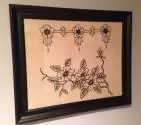Honoring Those Unknown Artisans

I don’t consider any of my journeys back to see my family in Illinois complete without an afternoon hitting some of my old antiquing haunts. Back when I was going to college at Western Illinois University and then teaching school a little further south, I loved rummaging through the shops in Monmouth, Macomb, Good Hope, Roseville, and Galesburg.
Of course, I was broke part of that time and living on a beginning teacher’s salary the rest, so I could only afford the real bargains. To this day I still remember the custom-made Roycroft rolltop desk that I spotted at a time when I did not even know what the “R” inside the orb-and-cross represented. But the thirty-dollar price tag kept me from even researching it, which would have been more difficult in 1969 than it is today.
But I have never forgotten it ….
My first stop last week was in downtown Galesburg, population 32,000, that when I was a child was a bustling center of commerce. This is where we came for dentist and doctor appointments, Christmas shopping at W.T. Grants, Sears, and J.C. Penny, and where I bought my first baseball glove, and my first Beatles’ records — for one dollar each. Today many of the factories that had supported Galesburg have closed, along with those large, downtown department stores, squeezed out of business by Target and Walmart at the north edge of town.
After the recession, small businesses began taking advantage of the discounted rents on these downtown buildings, including a few hardy antiques dealers. The group shops survive by combining both antiques and collectibles, with a heavy emphasis on the Midwest country look, but they have thus far been saved from the container loads of European “antiques” of dubious heritage that have contaminated so many shops along the Eastern seaboard.

I never fool myself into thinking that I’m going to stumble upon another Roycroft desk or great piece of Teco pottery, so I have changed my approach, looking for smaller Arts and Crafts items that aren’t prominently displayed. I now pause to carefully lift small stacks of pearl-white embroidered doilies and tablecloths, watching for the trademark Arts and Crafts brown linen stuck somewhere near the bottom.
On this day I found one. At first glance it did not seem to have much appeal. Done primarily in black thread, it lacked vibrant colors, but I was drawn to the dogwood blossoms on the branch. I stepped into the light to examine it more closely and could see traces of colored thread amid the design. The piece looked to have been intended as the front of a small pillow, but the frayed edges revealed that it had never been completed.
And at the bottom I spotted something else: the number “604” printed on the fabric, letting me know this had been a kit someone had ordered, perhaps though House Beautiful magazine. As I held the slightly stained fabric in my hand and studied the detailed embroidery stitches, I could imagine some young woman, sitting at home, excited about her newly-arrived embroidery kit, carefully tracing the lines with her needle and thread. From what I could see, she had completed the design, but for some unknown reason had never used it as a pillow cover. The puckered creases told me it had spent its entire life folded and tucked away in a sideboard drawer or hope chest.
The antiques dealer offering it considered her work worth one dollar, which is what I paid for it, more embarrassed than gleeful.
Back home, I almost put the textile in our own sideboard drawer, but then reconsidered. Putting aside more pressing duties, I bought a frame, warmed up our clothes iron, and in just a few minutes had carefully wrapped the pillow top around a stiff piece of acid-free mat board, slipped it into the frame, and hung it on the wall in our hallway.
There it serves as a daily reminder that these anonymous, home-made pieces are every bit as Arts and Crafts as a signed Roycroft desk.

Until next Monday,
“If you don’t go, you don’t know.”
Bruce
